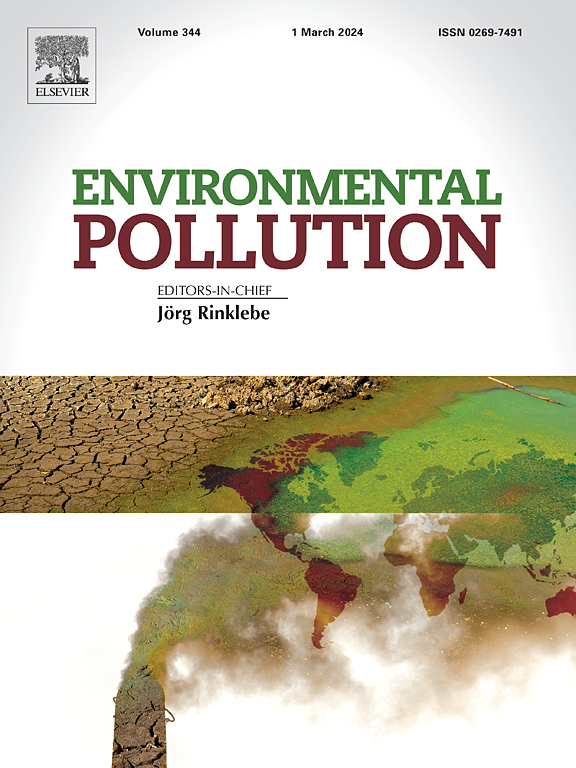使用转录组测序,类固醇激素及其组合影响F0亲和Gambusia affinis的昼夜节律通路:通过F1后代终身暴露和分子动力学验证
IF 7.3
2区 环境科学与生态学
Q1 ENVIRONMENTAL SCIENCES
引用次数: 0
摘要
雌激素和雄激素在水生环境中广泛分布,但它们在鱼类中潜在相互作用的分子机制尚不清楚。本研究评估了低(MTL)和高(MTH)浓度的17α-炔雌醇(EE2)、17α-甲基睾酮(MT)及其混合物(EE2+MTL和EE2+MTH)对两代亲鱼肝脏的影响。RNA测序揭示了F0雌性肝脏的治疗依赖性转录变化,比不同治疗之间重叠的差异表达基因更独特。单独或联合暴露于EE2和MT都会破坏F0女性的昼夜节律相关通路。此外,F1后代长期暴露于EE2、MT及其混合物中,显著改变了肝脏中昼夜节律相关基因(如nr1d1)的转录水平。构建了G. affinis NR1D1的精确三级结构,分子对接证实EE2、MT及其复合物与NR1D1结合。分子动力学模拟表明,EE2和MT配合物与NR1D1的结合自由能比EE2或MT单独的结合自由能低。这些发现表明,这两种激素和它们的混合物都有显著的潜力破坏豚鼠的昼夜节律。本文章由计算机程序翻译,如有差异,请以英文原文为准。


Steroid hormones and their combinations affect circadian rhythm pathway in F0 Gambusia affinis using transcriptome sequencing: validation by life-long exposure of F1 offspring and molecular dynamics
Estrogens and androgens are widely distributed in aquatic environments, yet the molecular mechanisms underlying their potential interactive effects in fish remain poorly understood. This study assessed the hepatic effects of 17α-ethinylestradiol (EE2), 17α-methyltestosterone (MT) at low (MTL) and high (MTH) concentrations, and their mixtures (EE2+MTL and EE2+MTH) in two generations of Gambusia affinis. RNA sequencing revealed treatment-dependent transcriptional changes in the liver of F0 female, with more unique than overlapping differentially expressed genes across treatments. Both individual and combined EE2 and MT exposure disrupted circadian rhythm-related pathways in F0 female. Moreover, long-life exposure of F1 offspring to EE2, MT, and their mixtures significantly altered the transcriptional levels of circadian rhythm-related genes (e.g., nr1d1) in the liver. The precise tertiary structure of G. affinis NR1D1 was constructed, and molecular docking demonstrated that EE2, MT, and their complexes bind to NR1D1. Molecular dynamics simulations revealed that the binding free energies of EE2 and MT complexes with NR1D1 were lower than those of EE2 or MT alone. These findings suggest that both hormones and their mixtures have significant potential to disrupt circadian rhythm in G. affinis.
求助全文
通过发布文献求助,成功后即可免费获取论文全文。
去求助
来源期刊

Environmental Pollution
环境科学-环境科学
CiteScore
16.00
自引率
6.70%
发文量
2082
审稿时长
2.9 months
期刊介绍:
Environmental Pollution is an international peer-reviewed journal that publishes high-quality research papers and review articles covering all aspects of environmental pollution and its impacts on ecosystems and human health.
Subject areas include, but are not limited to:
• Sources and occurrences of pollutants that are clearly defined and measured in environmental compartments, food and food-related items, and human bodies;
• Interlinks between contaminant exposure and biological, ecological, and human health effects, including those of climate change;
• Contaminants of emerging concerns (including but not limited to antibiotic resistant microorganisms or genes, microplastics/nanoplastics, electronic wastes, light, and noise) and/or their biological, ecological, or human health effects;
• Laboratory and field studies on the remediation/mitigation of environmental pollution via new techniques and with clear links to biological, ecological, or human health effects;
• Modeling of pollution processes, patterns, or trends that is of clear environmental and/or human health interest;
• New techniques that measure and examine environmental occurrences, transport, behavior, and effects of pollutants within the environment or the laboratory, provided that they can be clearly used to address problems within regional or global environmental compartments.
 求助内容:
求助内容: 应助结果提醒方式:
应助结果提醒方式:


